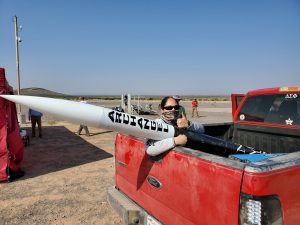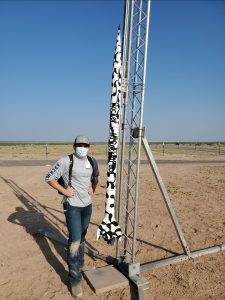By, Date 09/21/2020
New Mexico State University’s student rocket team the “Atomic Aggies” held two successful rocket launches at Spaceport America on Saturday, September 19.
 |
||
|
Anita Jimenez, Atomic Aggies Student Advisor with Archangel. (Spaceport America photo) |
The Atomic Aggies were due to compete in the 2020 Spaceport America Cup which was canceled due to COVID-19. The team mostly comprised of mechanical and aerospace engineering students from NMSU, had started work on their rockets in August 2019, and continued through the pandemic to finish their vehicles ahead of test day.
“Our main goal for this launch was to prove to ourselves and others that we could make a sounding rocket that would be a competitor in the Spaceport America Cup” said Adam Flores, Atomic Aggies Project Manager. “Even after the Cup was canceled, we felt compelled to follow through with our launch and our goals as if we were still in the competition. We maintained the same parameters and guidelines as the competition would. This time, instead of competing with other universities it was a battle between ourselves to prove we could make a successful rocket.”
The team’s rocket “Archangel” carried an 8.8lbs 3U CubeSat chile growing chamber during the flight. The team were aiming to reach an altitude of 10,000 feet and achieved a height of 8,333 feet. The avionics and payload both generated great data and the chiles survived the launch and return to Earth.
The other rocket named “Rocket McRocketFace” was developed by Scott Komar for his National Association of Rocketry Level 3 certification. Each year the Atomic Aggies allow a student to build and design their own rocket in order to get the Level 3 certification which shows judges at the Spaceport America Cup that the team is experienced with the larger class motors. Komar’s objectives were to launch with a M- class motor and safely recover his vehicle in order to get his Level 3 certification which he successfully achieved after one false start.
There are 30 active members of the NMSU Atomic Aggies team and several team members are the first recipients of the Galactic Unite STEM Scholarship at NMSU (https://www.galacticunite.com/new-mexico-state-university-scholarship). Additionally, the Atomic Aggies have been awarded grant funding through the Galactic Unite Grants program to support the design and build of their competition rocket. Four mentors from Virgin Galactic were onsite to support and cheer on the team’s hard work.
 |
||
| Scott Komar with “Rocket McRocketFace”. (Spaceport America photo) |
Spaceport America’s interim Executive Director Scott McLaughlin (who is a proud NMSU electrical engineer graduate) commented “It is great to see the Atomic Aggies team grow over the last few years, and very significant that they can travel just an hour to test their designs. New Mexico is now at the forefront commercial space developments and our colleges are starting to see the benefits of a nearby spaceport—both for their curriculum and for good aerospace jobs.”
Spaceport America continues to adhere to COVID-19 restrictions and all on site wore face masks and kept social distance throughout the launch. The team were limited to 10 members on site with the launches live streamed on social media for those that could not be there in person.
Spaceport America (https://www.spaceportamerica.com) is the first purpose-built commercial spaceport in the world. The FAA-licensed launch complex, situated on 18,000 acres adjacent to the U.S. Army White Sands Missile Range in southern New Mexico, has a rocket friendly environment of 6,000 square miles of restricted airspace, low population density, a 12,000-foot by 200-foot runway, vertical launch complexes, and about 340 days of sunshine and low humidity.
Some of the most respected companies in the commercial space industry are tenants at Spaceport America: Virgin Galactic, HAPS Mobile/ AeroVironment, UP Aerospace, and SpinLaunch. With customers. Boeing, EXOS Aerospace and Sugarhouse Aerospace regularly using the complex for testing and launches.
